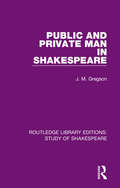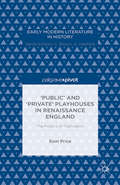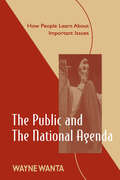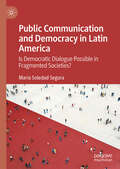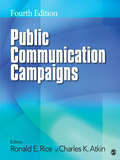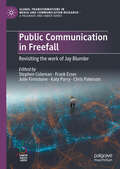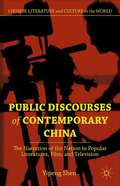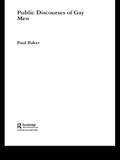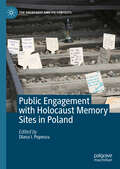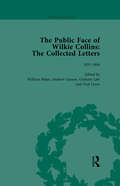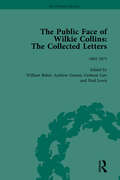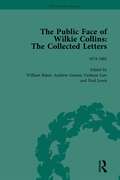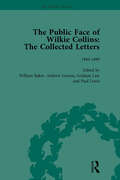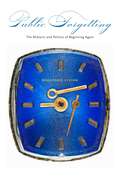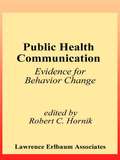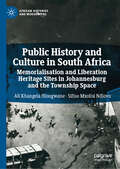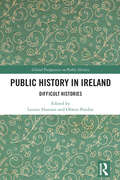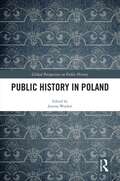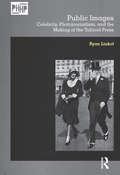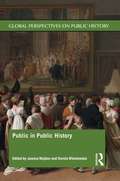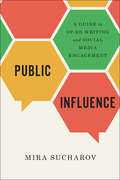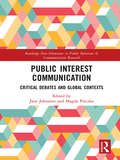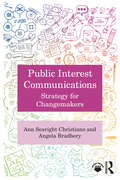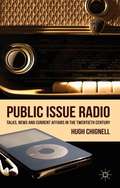- Table View
- List View
Public and Private Man in Shakespeare (Routledge Library Editions: Study of Shakespeare)
by J. M. GregsonThe potential duality of human character and its capacity for dissembling was a source of fascination to the Elizabethan dramatists. Where many of them used the Machiavellian picture to draw one fair-faced scheming villain after another, Shakespeare absorbed more deeply the problem of the tensions between the public and private face of man. Originally published in 1983, this book examines the ways in which this psychological insight is developed and modified as a source of dramatic power throughout Shakespeare’s career. In the great sequence of history plays he examines the conflicting tensions of kingship and humanity, and the destructive potential of this dilemma is exploited to the full in the ‘problem plays’. In the last plays power and virtue seem altogether divorced: Prospero can retire to an old age at peace only at the abdication of all his power. This theme is central to the art of many dramatists, but in the context of Renaissance political philosophy it takes on an added resonance for Shakespeare.
‘Public’ and ‘Private’ Playhouses in Renaissance England: The Politics of Publication (Early Modern Literature in History)
by Eoin PriceAt the start of the seventeenth century a distinction emerged between 'public', outdoor, amphitheatre playhouses and 'private', indoor, hall venues. This book is the first sustained attempt to ask: why? Theatre historians have long acknowledged these terms, but have failed to attest to their variety and complexity. Assessing a range of evidence, from the start of the Elizabethan period to the beginning of the Restoration, the book overturns received scholarly wisdom to reach new insights into the politics of theatre culture and playbook publication. Standard accounts of the 'public' and 'private' theatres have either ignored the terms, or offered insubstantial explanations for their use. This book opens up the rich range of meanings made available by these vitally important terms and offers a fresh perspective on the way dramatists, theatre owners, booksellers, and legislators, conceived the playhouses of Renaissance London.
The Public and the National Agenda: How People Learn About Important Issues
by Wayne WantaFocusing on the agenda-setting function of the news media from an information processing standpoint, this volume examines how individuals expose themselves to news media content and how this content translates into issue salience. It utilizes the individual as the unit of measurement. Many agenda-setting studies have used the issue, rather than the individual, as the unit of measurement. By employing an "agenda-setting susceptibility" index, the book details how individuals who actively process information in the news media are most susceptible to agenda-setting effects. Merging agenda-setting with research in information processing and uses and gratifications, it proposes and tests a causal model of media agenda-setting influences by examining demographics, psychological factors, and behavioral variables of individuals.
Public Communication and Democracy in Latin America : Is Democratic Dialogue Possible in Fragmented Societies?
by María Soledad SeguraThe book examines alternatives proposed and implemented by governments, civil society organizations, social movements and companies in Latin America to democratize public communication and overcome its current problems, such as the dissemination of alternative facts and fake news, anti-scientific discourse, harassing, discriminatory and hate speech, anti-human rights and anti-democracy discourses, and the contempt for political correctness. Drawing on theoretical approaches from media and communication, political studies and sociology, the book identifies strengths and weaknesses of the strategies for promoting democratic dialogue in Latin America and globally.
Public Communication Campaigns
by Ronald E. Rice Charles K. AtkinIn this new, fully revised and expanded fourth edition of Public Communication Campaigns, Rice and Atkin provide readers with a comprehensive, up-to-date look into the field of public communication campaigns. The subject of campaigns has become increasingly high profile in the academic world in the decade since the last edition, and hundreds of new studies on campaign theory and practice have been published since 2001. Largely rewritten to reflect the latest theories and research, this text continues in the tradition of ongoing improvement and expansion into new areas.
Public Communication in Freefall: Revisiting the work of Jay Blumler (Global Transformations in Media and Communication Research - A Palgrave and IAMCR Series)
by Stephen Coleman Frank Esser Katy Parry Julie Firmstone Chris PatersonThis book addresses key challenges facing global political communication at a time in which transformations in political practice, media ecology and cultural expectations both threaten traditional democratic norms and point to potential new ways of enacting political democracy. Drawing upon the outstanding theoretical insights of Jay Blumler to our understanding of the norms and practices of political communication, but also critically interrogating and updating them where appropriate, the volume asks timely questions about what publicness and democracy mean in the 2020s. Many people are talking and writing about the crisis of political democracy, fewer are talking about the role of the media in relation to that crisis. While many scholars have responded in an ad hoc way to the various crises of populism, polarisation, mis and disinformation, this book shows how Jay Blumler’s scholarship provides us with the tools and framework to research and understand the changing communication environment systemically and rigorously. The book demonstrates the applicability and relevance of Blumler’s work in explicating the current crisis of communication and the need for fresh and radical thinking in tackling it. The book's breadth and depth of chapters from a broad range of scholars from the East and West, ranging from long-standing contributors to the field to those in the early stages of their career, combine to produce a thoughtful and provocative invitation to reflect upon the concept of a ‘crisis of public communication’. We expect this book to become a major source for political communication students and scholars.
Public Discourses of Contemporary China
by Yipeng ShenExploring contemporary Chinese literature, film, and television, Yipeng Shen sheds light on the historical significance of nationalism for mass imagination and identification in the less-than-democratic system of China for the past three decades. Analyzing cultural products from a wide range of media, chapters move from the intellectual idealism of the 1980s, through the post-Tiananmen transition, to the national cinema of the 1990s, and finally to the Internet literature of today. Public Discourses of Contemporary China argues that Chinese subjects have, to varying degrees, transformed the state project of modernization into their own through mass aestheticization of the nation.
Public Discourses of Gay Men (Routledge Advances in Corpus Linguistics #Vol. 8)
by Paul BakerQueer linguistics has only recently developed as an area of study; however academic interest in this field is rapidly increasing. Despite its growing appeal, many books on ‘gay language’ focus on private conversation and small communities. As such, Public Discourses of Gay Men represents an important corrective, by investigating a variety of sources in the public domain. A broad range of material, including tabloid newspaper articles, political debates on homosexual law and erotic narratives are used in order to analyse the language surrounding homosexuality. Bringing together queer linguistics and corpus linguistics the text investigate how gay male identities are constructed in the public domain.
Public Engagement with Holocaust Memory Sites in Poland (The Holocaust and its Contexts)
by Diana I. PopescuThis book aims to address a neglected field of research by providing evidence-based insights into how contemporary visitors of different national and generational background, especially those of Polish and Jewish descent, experience and reflect on their visits, or on living in the proximity of different sites of memory across Poland, including former concentration and death camps, ghetto sites, and other physical sites such as museums with a connection to the Holocaust.
The Public Face of Wilkie Collins Vol 1: The Collected Letters
by Andrew Gasson Graham Law William BakerThe editors have transcribed 2,500 of Wilkie Collins's letters, around 700 of them previously unidentified, and have given them all a full scholarly annotation and context. The letters shed light on the personal life and business activities of this creative Victorian personality.
The Public Face of Wilkie Collins Vol 2: The Collected Letters
by Andrew Gasson Graham Law William BakerThe editors have transcribed 2,500 of Wilkie Collins's letters, around 700 of them previously unidentified, and have given them all a full scholarly annotation and context. The letters shed light on the personal life and business activities of this creative Victorian personality.
The Public Face of Wilkie Collins Vol 3: The Collected Letters
by Andrew Gasson Graham Law William BakerThe editors have transcribed 2,500 of Wilkie Collins's letters, around 700 of them previously unidentified, and have given them all a full scholarly annotation and context. The letters shed light on the personal life and business activities of this creative Victorian personality.
The Public Face of Wilkie Collins Vol 4: The Collected Letters
by Andrew Gasson Graham Law William BakerThe editors have transcribed 2,500 of Wilkie Collins's letters, around 700 of them previously unidentified, and have given them all a full scholarly annotation and context. The letters shed light on the personal life and business activities of this creative Victorian personality.
Public Forgetting: The Rhetoric and Politics of Beginning Again (G - Reference, Information and Interdisciplinary Subjects)
by Bradford VivianForgetting is usually juxtaposed with memory as its opposite in a negative way: it is seen as the loss of the ability to remember, or, ironically, as the inevitable process of distortion or dissolution that accompanies attempts to commemorate the past. The civic emphasis on the crucial importance of preserving lessons from the past to prevent us from repeating mistakes that led to violence and injustice, invoked most poignantly in the call of “Never again” from Holocaust survivors, tends to promote a view of forgetting as verging on sin or irresponsibility. In this book, Bradford Vivian hopes to put a much more positive spin on forgetting by elucidating its constitutive role in the formation and transformation of public memory. Using examples ranging from classical rhetoric to contemporary crises like 9/11, Public Forgetting demonstrates how, contrary to conventional wisdom, communities may adopt idioms of forgetting in order to create new and beneficial standards of public judgment concerning the lessons and responsibilities of their shared past.
Public Health Communication: Evidence for Behavior Change (Routledge Communication Series)
by Robert C. HornikThis volume argues the case that public health communication has affected health behavior. It brings together 16 studies of large-scale communication in a variety of substantive health areas--tobacco, drugs, AIDS, family planning, heart disease, childhood disease, highway safety--prepared by the authors who did the original research. These studies show important effects and illustrate the central conditions for success. The book also includes complementary analytic chapters which provide a meta-analysis of published results, some approaches to developing communication interventions, and alternative methods for evaluation of public health communication projects. Including studies based on communication programs in the United States, as well as projects done elsewhere in the world, including Europe, Africa, Asia and Latin America, this book: *offers a broad presentation of the alternative research designs that have been used to evaluate public health communication programs; *includes a great range of approaches from field experiments and natural experiments to simple before-after and complex time series designs, using data gathered from individuals and from archives; and *utilizes an innovative perspective on how to exercise public health communication from a leading and thoughtful practitioner. As such, it is required reading for scholars, students, practitioners, and policymakers in public health, health communication, health psychology, and related areas.
Public History and Culture in South Africa: Memorialisation and Liberation Heritage Sites in Johannesburg and the Township Space (African Histories and Modernities)
by Ali Khangela Hlongwane Sifiso Mxolisi NdlovuThe post-apartheid era in South Africa has, in the space of nearly two decades, experienced a massive memory boom, manifest in a plethora of new memorials and museums and in the renaming of streets, buildings, cities and more across the country. This memorialisation is intricately linked to questions of power, liberation and public history in the making and remaking of the South African nation. Ali Khangela Hlongwane and Sifiso Mxolisi Ndlovu analyse an array of these liberation heritage sites, including the Hector Pieterson Memorial and Museum, the June 16, 1976 Interpretation Centre, the Apartheid Museum and the Mandela House Museum, foregrounding the work of migrant workers, architects, visual artists and activists in the practice of memorialisation. As they argue, memorialisation has been integral to the process of state and nation formation from the pre-colonial era through the present day.
Public History in Ireland: Difficult Histories (Global Perspectives on Public History)
by Leonie Hannan Olwen PurdueThrough a collection of essays that reflect the complexity of the island’s historical past as it operates today, Public History in Ireland delivers a scholarly yet accessible introduction to contemporary topics and debates in Irish public history.Despite the reputation that Ireland, both north and south, has gained as a place of contestation, this is the first book-length study to tackle its diverse and often ‘difficult’ public histories. Public History in Ireland offers examples drawn not only from museums, heritage and collections, prime mediators of public historical interpretation, but also from the work of artists and academics. It considers the silences in Ireland’s history-telling, including those of the recent conflict in Northern Ireland and of the traumatic public discoveries and re-evaluations of the island’s institutions of social control. The book’s key message is that history is active, making itself felt in ongoing debates about heritage, identity, nationhood, post-conflict society and reparative justice. It shows that Irish public history is freighted and often fraught with jeopardy, but as such it is rich with insight that has relevance far beyond this island’s shores.This book is useful for students, scholars and practitioners working in the fields of public history and the history of Ireland.
Public History in Poland (Global Perspectives on Public History)
by Joanna WojdonThis volume presents various aspects of public history practices in Poland, alongside their historical development and theoretical reflections on public history. Despite a long tradition and variety of forms of public history, the very term "public history", or literally speaking "history in the public sphere", has been in use in Poland only since the 2010s. This edited collection contains chapters that focus on numerous practices and media forms in public history including historical memory, heritage tourism, historical re-enactments, memes and graphic novels, films, archives, archaeology and oral history. As such, the volume brings together the Polish experiences to wider international audiences and shares Polish controversies related to public history within the academic discourse, beyond media news and politically engaged commentaries. Furthermore, it sheds crucial light on the developments of collective memory, historical and political debates, the history of Poland and East-Central Europe, and the politics of post-World War Two and post-communist societies. Authored by a team of academic historians and practitioners from the field, Public History in Poland is the perfect resource for students from a variety of disciplines including Public History, Heritage, Museum Studies, Anthropology, and Archaeology.
Public Images: Celebrity, Photojournalism, and the Making of the Tabloid Press (Photography, History: History, Photography)
by Ryan LinkofThe stolen snapshot is a staple of the modern tabloid press, as ubiquitous as it is notorious. The first in-depth history of British tabloid photojournalism, this book explores the origin of the unauthorised celebrity photograph in the early 20th century, tracing its rise in the 1900s through to the first legal trial concerning the right to privacy from photographers shortly after the Second World War. Packed with case studies from the glamorous to the infamous, the book argues that the candid snap was a tabloid innovation that drew its power from Britain's unique class tensions. Used by papers such as the Daily Mirror and Daily Sketch as a vehicle of mass communication, this new form of image played an important and often overlooked role in constructing the idea of the press photographer as a documentary eyewitness. From Edward VIII and Wallis Simpson to aristocratic debutantes Lady Diana Cooper and Margaret Whigham, the rage of the social elite at being pictured so intimately without permission was matched only by the fascination of working class readers, while the relationship of the British press to social, economic and political power was changed forever.Initially pioneered in the metropole, tabloid-style photojournalism soon penetrated the journalistic culture of most of the globe. This in-depth account of its social and cultural history is an invaluable source of new research for historians of photography, journalism, visual culture, media and celebrity studies.
Public in Public History (Global Perspectives on Public History)
by Joanna Wojdon Dorota WiśniewskaPublic in Public History presents international research on the role of the public in public history: the ways people perceive, respond to and influence history-related institutions, events, services and products that deal with the past. The book addresses theoretical reflections on the public, or multiple publics, and their role in public history, and empirical analyses of the publics’ active responses to and impact on existing forms of public history. Special attention is also paid to digital public history, which facilitates the double role of the public—as both recipient and creator of public history. With a multinational author team, the book is based on various national, but also international, experiences and academic traditions; each chapter goes beyond national cases to look transnationally. The narratives built around their cases deal with issues such as arranging a museum exhibition, managing a history-related website, analyzing readers’ comments or involving non-professional public as oral history researchers. With sections focusing on research, commemorations, museums and the digital world, this is the perfect collection for anyone interested in what the public means in public history.
Public Influence: A Guide to Op-Ed Writing and Social Media Engagement
by Mira SucharovHow can twenty-first-century scholars and other experts craft their voices for audiences beyond their peers? In Public Influence, political scientist Mira Sucharov walks readers through the ins and outs of op-ed writing and social media engagement. Presented in a lively and engaging style, Public Influence coaches readers on the best approach to pitching and writing op-eds and other related analytical pieces, managing the ensuing conversation, conveying informed ideas to an evidence-resistant audience, avoiding social media hazards in an increasingly polarized environment, harnessing outrage culture to organize sensitively and intelligently, and using political labels in ways that cut through the noise. Enlivened with discussions of an array of hot-button issues and examples of public influence succeeding wildly and going terribly awry, Public Influence is essential reading for anyone who wants to harness the opportunities of public engagement in a dynamic digital age.
The Public Intellectual and the Culture of Hope
by Jason Haslam Joel FaflakThe Public Intellectual and the Culture of Hope brings together a number of winners of the Polanyi Prize in Literature - a group whose research constitutes a diversity of methodological approaches to the study of culture - to examine the rich but often troubled association between the concepts of the public, the intellectual (both the person and the condition), culture, and hope. The contributors probe the influence of intellectual life on the public sphere by reflecting on, analyzing, and re-imagining social and cultural identity.The Public Intellectual and the Culture of Hope reflects on the challenging and often vexed work of intellectualism within the public sphere by exploring how cultural materials - from foundational Enlightenment writings to contemporary, populist media spectacles - frame intellectual debates within the clear and ever-present gaze of the public writ large. These serve to illuminate how past cultures can shed light on present and future issues, as well as how current debates can reframe our approaches to older subjects.
Public Interest Communication: Critical Debates and Global Contexts (Routledge New Directions In Public Relations And Communication Research Ser.)
by Jane Johnston Magda PieczkaCommunication has become the technology of public interest, demanding a re-examination of the key concept of public in both public relations and communication theory. This book defines a new concept of public interest communication, combining the conflict, negotiation and adaptation inherent in public interest, with a critical approach to communication management and public relations. Combining conceptual discussions about public theories of language with the tension between the public and private interests for public relations professionals, the book uses case studies to explore the negotiation of conflicting interests and the construction of the public interest within systems of governance at local, national and international levels. Public interest communication is identified within social and cultural contexts that resonate globally – health, community, media and the environment - each representing interest conflicts within the changing global environment. Addressing the forces of fragmentation, inequality and individualisation that characterize the modern world, this thought-provoking volume will be of great interest to researchers and advanced students of communication, public relations, environmental communication, public communication, and public policy.
Public Interest Communications: Strategy for Changemakers
by Ann Searight Christiano Angela BradberyWritten by two practitioners with deep professional experience, this book introduces readers to public interest communications, which takes an evidence-based approach to using strategic communications to drive positive social change.Each chapter includes accessible, applicable insights, exercises and real-world examples undergirded by theories and research from a range of academic disciplines: social and cognitive science, communications, systems thinking and human-centered design. The authors provide step-by-step frameworks for practicing public interest communications and illustrate each framework with multiple perspectives through practitioner interviews. Through a focus on fairness and ethics, the book helps readers acquire the mindset of a public interest communicator.This book is an ideal resource for students in strategic communications, health and environmental communications, public relations, journalism, social entrepreneurship, political science and advertising, and in public interest communication courses specifically, who wish to promote lasting change on issues that advance the greater good.Accompanying online materials include worksheets and links to further resources such as videos and podcasts. Please visit www.routledge.com/9781032531915.
Public Issue Radio: Talks, News and Current Affairs in the Twentieth Century
by Hugh ChignellBased on original and previously unseen written and sound archives and interviews with former and current radio producers and presenters, Public Issue Radio addresses the controversial question of the political leanings of current affairs programmes, and asks if Analysis became an early platform for both Thatcherite and Blairite ideas.
